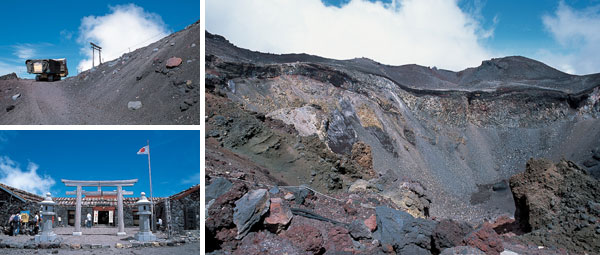| Web Japan > NIPPONIA No.35 > Special Feature* |
|
|
|
NIPPONIA No.35 December 15, 2005 |

Top Left: This rough road is for bulldozers carrying material and equipment to the summit. It is off-limits to hikers.
Bottom Left: The far sanctuary of Sengen Taisha Shrine at the summit. All land above the eighth station is considered to be inside the sanctuary grounds.
Right: The crater at the summit is about 200 meters deep and 2 kilometers in circumference.
My trek to the top began again when the sky brightened, and it seemed to me that I was almost there. But walking was a lot more difficult. When I looked up at the beginning of my climb from the fifth station, I had thought I could see the summit, but the place I was looking at then turned out to be only the eighth of ten stations, at 3,250 meters above sea level. That meant more than another 500 meters of altitude to conquer. After the eighth station, the landscape became desolate—no flowers in bloom, no vegetation at all. The slope was steeper, and the lava and loose stones slowed me down a lot.
I weigh in on the heavy side—close to 100 kg—and my legs were beginning to complain. The sun beat down without a break, scorching my skin. Breathing became difficult, and I was sweating a lot. When I left the seventh station I had one liter of water, but by this time it was all gone. People kept passing me on their way up.
The day before, a Shinto priest at the Sengen Shrine had told me that an old man—“Yes, he was 104 years old!”—had made it to the top. The priest, Watanabe Shin, had meant to encourage me, but now I was simply depressed and discouraged.
At the ninth station, I bought some water. At 3,460 meters above sea level, water is a precious commodity—a 500 ml plastic bottle costs 500 yen. I took a short break, but then everything around me seemed to take on a slightly yellow hue. A middle-aged man stopped for a moment and said, “You've got a case of mountain sickness. If you're going to keep going up, go slowly.”
Two hours later, I finally reached my destination: the torii gate for Sengen Taisha Okumiya Shrine, at the top of the Fujinomiya-guchi trail (elevation 3,720 meters). The summit was close by, at 3,776 meters above sea level.
Above, the airplanes flying at cruising altitude seemed remarkably large. Now, finally, I had a real sense that I was at the highest place in Japan. A sea of clouds hid the land below, and the blue sky above stretched out seemingly forever.
I walked behind the shrine to look at the crater. I saw a huge gaping hole, colored with large slashes of reddish brown, ready to swallow me up. My upper body was covered with nothing but a T-shirt, the air temperature was a chilly 5 ゚C, and my perspiration had dried, leaving my skin cold. A few minutes later, with head pounding and muscles aching more than ever, I turned away from the summit and staggered down toward the clouds.
|

Keeping Fuji Beautiful
for Future Generations Watanabe Shin, a priest at Fuji-san Hongu Sengen Shrine, says his earnest wish is that the slopes of Mount Fuji will remain beautiful for future generations. The shrine organizes a number of nature conservation activities. The increase in the number of climbers and their plastic litter became noticeable beginning in the 1970s, but volunteers are now cleaning it all up and keeping the mountain slopes in their natural state. Watanabe has some advice: “If you come here, be sure to drink water from the natural springs. Then you will really appreciate the blessings of nature.”
|
|
||||||
|